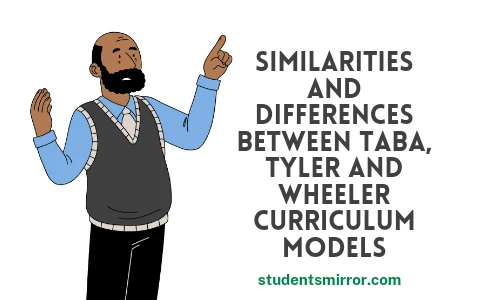In this article, we’ll be looking at the Taba, Tyler, and Wheeler Curriculum models as we pertinently bring out similarities and differences between them.
Differences between the Tyler, Taba and Wheeler Models of Curriculum
Definition
The Tyler model of curriculum was developed by the American educator Ralph Tyler in the 1940s, while the Wheeler model is a cyclic model of curriculum developed by D. K. Wheeler in 1967.
Nature
Tyler’s model is linear, while Wheeler’s model is cyclic.
Phases
Tyler’s model has four main components: objectives, selection of learning experiences, organization of learning experiences, and evaluation. Wheeler’s model, on the other hand, has five phases: aims, goals, and objectives; learning experiences; selection of content; organization and integration of learning experiences and content; and evaluation.
Evaluation
Although both models have an evaluation phase, in Tyler’s model, evaluation is terminal since it is the last phase in a linear model, but in the Wheeler model, evaluation is not terminal. However, in the Wheeler model, the feedback from the evaluation phase is fed back into objectives and goals.
Content and learning experience
In the Tyler model, there is no separate component for “content” while in the Wheeler model, content is separated from the learning experiences from which it’s developed.
The key difference between the Tyler and Wheeler models of curriculum is that the Tyler model fundamentally comprises four concepts and is a linear model adapted for curriculum development, whereas the Wheeler model comprises five theories and was developed as a cyclical model.
What is the difference between the Tyler and Taba models?
The Tyler model and the Taba model are two curriculum development models. The Tyler model was developed by Ralph Tyler, and the Taba model was developed by Hilda Taba.
The key difference between the Tyler model and the Taba model is that the Tyler model is a linear model that consists of four basic concepts, whereas the Taba model consists of seven steps.
The Tyler model basically focuses on offering freedom for students to select what they learn, whereas the Taba model offers the opportunity for teachers to develop the curriculum.
In the Taba model, teachers can identify the needs of the students, and the curriculum should be developed according to the needs and levels of the students. Active engagement and interaction of students are encouraged by the theories of the Tyler model, while the Taba model encourages interactive activities within the classroom.
The Tyler model gives great opportunities for students to explore their own interests, and the Taba model gives opportunities for teacher interaction in the class activities.
Taba Model of Curriculum
- The Taba Model of Curriculum is a rational and objective model.
- The Taba Model of Curriculum is an inductive approach. For example, teachers should begin the process by creating specific T&L units for the SS rather than engaging initially in creating a general curriculum design.
- The Taba Model of Curriculum consists of 5 elements:
- Objective
- Content
- Learning experiences
- Teaching strategies
- Evaluation measures
- The Taba Model of Curriculum is designed by the teachers rather than handed down by higher authority.
Tyler Model of curriculum
- Tyler’s model of curriculum is a rational/objective model.
- It’s the best-known model for curriculum development.
- It’s deductive, for it proceeds from general to specific.
- Tyler’s model of curriculum is a straight-line model. It consists of the following:
- Objective
- Choice
- Organisation
- Evaluation
- Its goals and objectives are essential
APPLY FOR ACCESS BANK STUDENT LOAN
Wheeler Model of Curriculum
- The Wheeler Model of Curriculum is a cyclical model.
- Its ideas are in a cyclic form (Tyler’s original Ideas)
- Wheeler’s model of curriculum is a spherical model. It consists of the following
- Experiences
- Choosing learning
- Choosing content
- Organizing and learning
Similarities Between the Tyler, Taba and Wheeler Models of Curriculum
Both Tyler and Taba’s curriculum models are referred to as “rational” curriculum models because they are designed around objectives. Tyler’s model also identifies clear and easy-to-follow key stages that need to be considered.
Tyler and Taba’s models are both linear in design. Tyler’s model is deductive, and Taba’s is inductive. Linear models are not curricular models that follow procedural steps. Both models can be used at the school and national levels.
Both models are used for education purposes but have different approaches.
Tyler, Taba, and Wheeler models of curriculum provide structure for examining the model.
They are designed to provide a basis for decisions regarding the following:
- Selection
- Structuring
- Sequencing of the educational experiences
Tyler, Taba, and Wheeler model of curriculum involves the curriculum development process.
Reference: Differencesbetween.com, Wikipedia.

